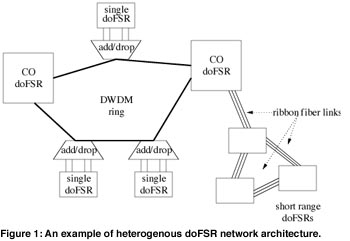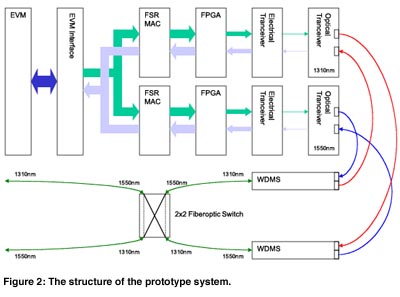

by Kari Seppänen, Ulf Betlehem, Risto Mutanen, and Juha Zidbeck
Exponentially increasing Internet protocol (IP) traffic and new quality of service sensitive applications require cost efficient solutions throughout the network. WDM technology has provided solutions for transport networks at the backbone level, and similar solutions are emerging for metropolitan area networks (MAN). One important issue is how the network is controlled and how its resources are shared. A network system that is scalable from local switching networks to wide area networks (WAN) has been developed at VTT Information Technolgy, based on their proven frame synchronised ring (FSR) concept. It does not depend on a particular transport network, but it is adaptable from parallel optical links to dense WDM systems.
The original FSR is a ring-structured switching network where adjacent nodes are connected together by unidirectional point-to-point links. At the beginning it was applied as a parallel backplane bus that had separate control signals and data bus carrying fixed length frames. The medium access control (MAC) is decentralised and it guarantees fair resource allocation between the nodes. Multiple rings can be connected together to create larger and more complex network configurations. Later, a serialised FSR, in which all control and data signals are transferred using a single serial link, has been developed.
The FSR frame can be tailored to match the particular application used. It is composed of a header, payload and optional trailer fields. The header field includes source and destination addresses. The latter one is not encoded but there is one bit reserved for each node enabling efficient multicast support. Members of a multicast connection could be added and removed dynamically. Thus handovers required by mobile traffic are also efficiently supported.
The occupied frames are destination released: compared to multidrop or source release ring the FSR has double capacity on the average. In a FSR system consisting two counter-rotating rings, capacity of a single ring is doubled again, as the frames have to travel shorter distance. This means that the aggregate capacity in such system is 8 times of the capacity of a single internodal link.
Distributed Optical FSR
The doFSR is a serialised FSR with high-speed optical links between nodes. The basic setup consists of two counter-rotating rings, but bus capacity can be scaled up by using multiple WDM channels or parallel fiber links. A large doFSR system can be composed of dozens of pairs of parallel counter-rotating rings. The doFSR adapts itself automatically into a large variety of internodal distances, so it scales from local area networks (LAN) to wide area networks (WAN).
Different kinds of nodes and subnetworks can be connected to a doFSR network. A simple node may have only a single line card which is attached to a doFSR network through a DWDM add-drop multiplexer. A large central office (CO) type node have multiple line cards and all DWDM channels are terminated. As use of WDM components is not cost effective at short ranges, parallel optical links can be applied instead. At very short distances signals can be transmitted in electrical domain using, eg, parallel low voltage differential signals (LVDS) links.

Each doFSR line card is attached to one clockwise and to one counter-clockwise rotating lightpath. All doFSR nodes have protection switches to ensure system operation in case of node failure. In nodes with multiple line cards each slot can be equipped with own protection switch to enable hot swap operation. Adaptation to a changed network configuration after failures is automatic.
Prototype System
The prototype implementation demonstrates the doFSR concept with one pair of counter rotating rings in single fiber using coarse WDM components. The prototype was built as a daughterboard for a 3rd party DSP-card, which provides a convenient platform for testing and further development. Transmission clocks are synchronised to a single clock source using local PLL controlled crystal oscillators to minimise jitter. Serialisation control, word-alignment and synchronisation are implemented using high-speed pro-grammable logic devices. The nodes contain two switching FSR buses that can be used independently of each other. Flexible design supports automatic network reconfiguration when nodes are added or removed.

We have developed a Linux PCI network driver with bus-mastering capabilities for efficient data transfers. The DSP board utilises DMA-channels, which minimises overhead and allows the CPU to control the header manipulation. The prototypes have been tested with realistic IP traffic using fiber lengths from a couple of meters to several kilometers.
Distributed IP Router
A distributed IP router will be the first application for doFSR. It will transfer datagrams directly without intermediate layers, effectively acting as a decentralised IP-switch. In this way the workload of IP routing operations can be shared between doFSR nodes at the edge of the network. As internodal distances can be rather long, many hops between routers taking place in legacy router networks can be avoided.
Conclusions
We have developed doFSR, an efficient ring structured network based on a proven concept. Extremely scalable design makes it an ideal solution for applications ranging from distributed computing environments to edge networking Furthermore, a doFSR based IP network can be a cost efficient high performance alternative for access, feeder and backbone networks.
Links:
doFSR home page: http://www.vtt.fi/tte/rd/optical-networking/doFSR/
Please contact:
Kari Seppänen - VTT Information Technology
Tel: +358 9 456 5610
E-mail: Kari.Seppanen@vtt.fi